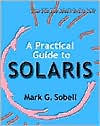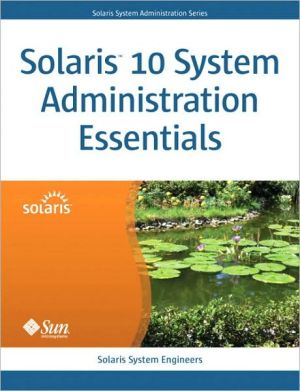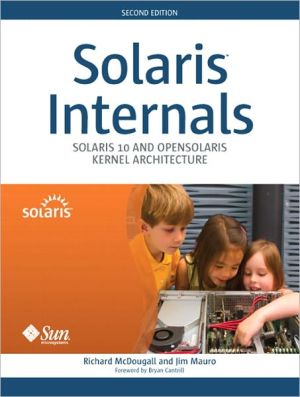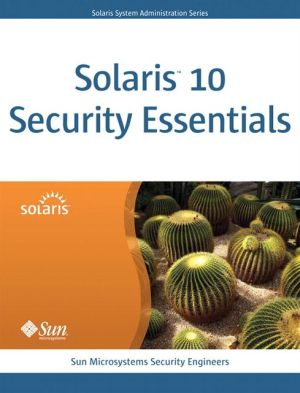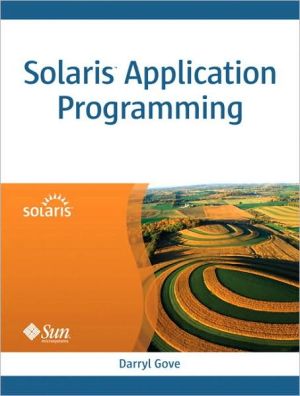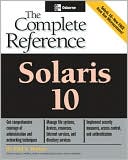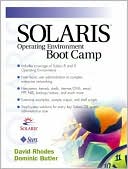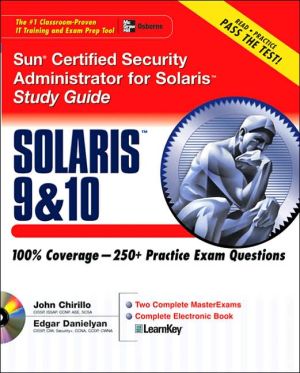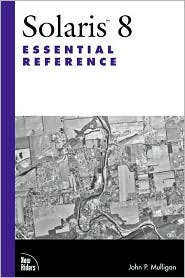A Practical Guide to Solaris
Search in google:
Written by best-selling author Mark G. Sobell, A Practical Guide to Solaris enables both novice and experienced users to quickly learn Sun Microsystems' popular Solaris operating system. Designed to maximize accessibility, the book is divided into three parts. Part I is a tutorial that brings novice users--those with no UNIX/Solaris background, or no programming experience at all--quickly up to speed. Part II is geared toward intermediate and advanced users. Part III is a comprehensive reference guide covering more than ninety Solaris utilities with a clarity of explanation and range of examples not available from any other source. A Practical Guide to Solaris provides invaluable information on the following: Solaris 7 (a.k.a. Solaris 2.7), as well as Solaris 2.6 and earlier versions for Intel and SPARC hardware. For beginning and experienced end users and C and shell programmers using either a command line or GUI interface. Graphical User Interfaces (GUIs). Learning and using the X Window System and the CDE and OpenLook desktop managers. Offers extensive discussions of CDE and X customization. Networking, the Internet, and the World Wide Web. Explains what a network is, how it works, and how you can use it. Discusses types of networks, network implementations, distributed computing, how to use the network for communicating with other users, and using various networking utilities (such as rcp, telnet, ftp, nslookup, and more). Shells. Describes how to use the Bourne (sh), C (csh), and Korn (ksh) Shells as interactive command interpreters and as programming languages so you can write shell scripts. Extensive coverage of builtin commands, shell variables, options, customization, functions, and programming techniques. System Administration. Covers system operation from SPARC PROM mode/booting an Intel x86 through multiuser mode; types of files, including symbolic links and special files; adding and removing users, printers, devices and drivers; installing software, sharing and backing up filesystems, network services, system reports (sar, iostat, and more) and admintool; installing patches and system software; and problem solving. Programming Tools and Concepts. Covers both the Solaris (cc) and GNU (gcc) C compilers, debugging (lint and gcc warnings), shared libraries, make, SCCS, and more. These essential topics are presented in a clear, easy-to-understand format with the help of the following: Examples. Both interactive and shell script examples are used throughout Parts I and II to provide added insight into Solaris features. Part III includes examples of more than ninety Solaris utilities. Tutorials. Step-by-step tutorials cover the vi, dtpad (CDE), and textedit (OpenLook) text editors; the dtmail (CDE), mailtool (OpenLook), and pine mail programs; the pine and Netscape newsreaders; the Netscape browser; and how to use a search engine. All tutorials are illustrated with real-world examples so you can practice as you read. Appendixes and Glossary. These cover regular expressions, POSIX standards, and security. The Help! appendix provides assistance on using your hardware and for locating, downloading, and installing Sun, public, and GNU software (including gzip and gcc). A Web site . Maintained by the author, this site provides help in locating Solaris documentation, software, patches, and free items, as well as corrections to, and downloadable examples from, this book. Sys Admin - Elizabeth Zinkann A Practical Guide to Solaris is an effective and thorough means to learn how to use or administer a Solaris system. The author demonstrates the aspects and capabilities of Solaris through its options and possible configurations. He reviews various windowing alternatives, SCCS (Source Code Control System), daily system operations, processes, encryption, POSIX Standards, networking, shell programming, email, and employs tutorials when applicable. A Practical Guide to Solaris is an outstanding book, providing a comprehensive study of the advantages and qualities of Solaris 2.
Preface Audience Benefits xlv Scope of Coverage and Features Parts I, II, and III Supplements Thanks Part I Introduction to Solaris Chapter 1 The Solaris Operating System The Heritage of UNIX Whatís So Good about Solaris? System Features Standards Binary Compatibility The Standardization of UNIX How Can UNIX Run on Different Computers/Processors? The C Programming Language Overview of Solaris Solaris Has a Kernel Programming Interface Supports Many Tasks at One Time Supports Many Users at One Time Solaris Provides a Hierarchical Filesystem with Builtin Security The Shell Is a Command Interpreter and Programming Language 8 Filename Generation Device-Independent Input and Output Shell Functions Job Control A Large Collection of Useful Utilities Interprocess Communication System Administration Additional Features of Solaris Graphical User Interfaces (Inter)networking Utilities Software Development Screen-Oriented and Graphical Editors Advanced Electronic Mail GNU/FSF Summary Review Exercises Chapter 2 Getting Started Before You Start Name and Version of the Operating System Conventions Keys and Characters Utility Names Filenames Shell and Builtin and Variable Names Items You Enter Prompts and RETURNs Optional Information Solaris2 Designation Logging In Graphical User Interface (GUI) Character-Based Interface Incorrect Login The Shell Logging Out Terminal Emulation and telnet Superuser Correcting Mistakes Erasing a Character Deleting a Word Deleting a Line Aborting Execution passwd: Changing Your Password Documentation AnswerBook2 man and xman: Displaying the System Manual Editing a File Tutorial: dtpad: Creating and Editing a File Correcting Mistakes Moving the Cursor Highlighting Text Saving a File Ending an Editing Session Tutorial: textedit: Creating and Editing a File Getting Started Correcting Mistakes Moving the Cursor Highlighting Text Saving a File Ending an Editing Session Basic Utilities ls: Listing the Contents of a Directory cat: Displaying a Text File pg or more: Displaying a Long Text File rm: Deleting a File hostname: Displaying a Machine Name Quoting Special Characters Summary Review Exercises Advanced Review Exercises Chapter 3 The Solaris Utilities Working with Files cp: Copy a File mv: Change the Name of a File lp: Print a File grep: Find a String head: Display the Beginning of a File tail: Display the End of a File sort: Display a File in Order uniq: Remove Duplicate Lines in a File diff: Compare Two Files file: Test the Contents of a File unix2dos: Convert Solaris Files to DOS/Windows Format Three Useful Utilities echo: Display Text date: Display the Time and Date script: Record a Solaris Session Compressing and Archiving Files compress: Shrink a File uncompress, zcat: Expand a File tar: Pack and Unpack a File Locating Commands which, whereis: Locate Utilities apropos: Search for Keywords Obtaining User and System Information who: List Users on the System finger: List Users on the System w: List Users Communicating with Other Users write: Send a Message talk: Communicate with Another User mesg: Deny or Accept Messages Electronic Mail Similarities between dtmail and mailtool Tutorial: Using dtmail or mailtool to Send and Receive Electronic Mail Reading Mail Sending Mail Header Alias Tutorial: Using pine to Send and Receive Electronic Mail Getting Started Sending Mail Receiving Mail Sending Mail to More Than One Person Network Addresses Summary Review Exercises Advanced Review Exercises Chapter 4 The Solaris Filesystem The Hierarchical Filesystem Using the Hierarchical Filesystem Directory and Ordinary Files Filenames Filename Extensions Invisible Filenames mkdir: Create a Directory cd: Change to Another Working Directory The Working Directory Significance of the Working Directory Your Home Directory Startup Files Absolute Pathnames Relative Pathnames The . and .. Directory Entries Important Standard Directories and Files Working with Directories rmdir: Delete a Directory Using Pathnames Special Pathnames mv, cp: Move or Copy a File mv: Move a Directory Access Permissions ls ñl: Display Permissions chmod: Change Access Permissions Setuid and Setgid Permissions Directory Access Permissions Links ln: Create a Link cp versus ln Symbolic Links Creating a Symbolic Link Using Symbolic Links to Change Directories Symbolically Linked Directories under the Bourne and C Shells Symbolically Linked Directories under the Korn Shell rm: Remove a Link Summary Review Exercises Advanced Review Exercises Chapter 5 The Shell I The Command Line Syntax Command Name Arguments Options Processing the Command Line Executing the Command Line Standard Input and Standard Output The Window/Terminal as a File The Window/Terminal as Standard Input and Standard Output 107 Redirection Redirecting Standard Output Redirecting Standard Input Appending Standard Output to a File /dev/null Pipes Filters tee: Sending Output in Two Directions Running a Program in the Background Filename Generation/Pathname Expansion The ? Special Character The k Special Character The [] Special Characters Summary Review Exercises Advanced Review Exercises Part II Intermediate/Advanced Solaris Chapter 6 Graphical User Interfaces What Is a GUI? Using a GUI Logging In Menus Dialog Boxes Screen Layout Window Manager Desktop Manager Workspace Manager CDE Desktop Manager Front Panel Title Bar Common OperationsóMenus Window Menu Workspace Menu Logging Out Working with Windows Closing a Window Opening a Terminal Emulator Window Moving a Window Resizing a Window Raising and Lowering Windows Scrolling Text Motif Scroll Bar Athena Scroll Bar OpenLook Scroll Bar Using Icons File Manager The View Menu The View/Set View Options Window Properties Copying and Pasting Text X Window System X Window System Window Managers X Window System and Solaris Bringing Up the X Server Remote Computing and Local Displays Local X Server, Remote Display Local Display, Remote X Server Stopping the X Server Customizing Your X Work Environment Remapping Mouse Buttons Customizing X Applications on the Command Line Setting X Resources Customizing CDE Style Manager Tools Color Window Font Window Backdrop Window Keyboard Window Mouse Window Beep Window Screen Window Window Window Startup Window .dtprofile Building Menus Actions Front Panel Login Manager Session Manager Initialization Files Login Screen Issuing Commands before and after the Session Session Setup OpenLook Window Manager Workspace Menu File Manager Customizing the Desktop Saving the Desktop Help Viewer Customizing Menus Application Preferences X Applications Summary Review Exercises Chapter 7 Networking and the Internet Network Services Intranets Common Types of Networks Local Area Networks (LANs) Ethernet Wide Area Networks (WANs) Internetworking through Gateways and Routers Network Protocols Host Addresses Subnets Communicating over the Network finger: Learn about Remote Users Sending Mail to a Remote User talk: with a Remote User Mailing List Servers Networking Utilities ping: Test a Network Connection rlogin, telnet: Access a Remote Computer Trusted Hosts and the .rhosts File rcp, ftp: Transfer Files over a Network Anonymous ftp rsh: Run a Command Remotely traceroute: Trace a Route over the Internet rwho: List Users on Remote Computers nslookup: Query Internet Name Servers whois: Look Up a User on the Internet Distributed Computing The Client/Server Model Overview of Domain Name Service (DNS) Network Information Service (NIS) Network File System (NFS) automount: Automatic Filesystem Mounting Network Services/Daemons USENET Tutorial: Using pine as a Newsreader Subscribing to Newsgroups Reading News Posting News Unsubscribing from Newsgroups Overview of the World Wide Web Tutorial: Using Netscape Screen Elements Navigating the Web Reading Netnews Downloading Files Using Bookmarks Using a Search Engine Other WWW Browsers More about URLs Creating Your Own Web Page Summary Advanced Review Exercises Chapter 8 The vi Editor History Tutorial: Using vi to Create and Edit a File Specifying a Terminal Starting vi Command and Input Modes Entering Text Ending the Editing Session Introduction to vi Features Modes of Operation The Display The Status Line Redrawing the Screen The Tilde (~) Symbol Correcting Text as You Insert It Command Case The Work Buffer Line Length and File Size Abnormal Termination of an Editing Session Recovering Text after a Crash Command ModeóMoving the Cursor Moving the Cursor by Characters Moving the Cursor by Words Moving the Cursor by Lines Moving the Cursor by Sentences and Paragraphs Moving the Cursor within the Screen Viewing Different Parts of the Work Buffer Input Mode The Insert Commands The Append Commands The Open Commands The Replace Commands The Quote Command Command ModeóDeleting and Changing Text The Undo Command The Delete Character Command The Delete Command The Change Command The Substitute Command The Case Command Searching and Substituting Searching for a Character Searching for a String Special Characters in Search Strings Substituting One String for Another The Substitute Address The Search and Replace Strings Miscellaneous Commands The Yank, Put, and Delete Commands The General-Purpose Buffer The Yank Command The Put Commands The Delete Commands The Named Buffers The Numbered Buffers Reading and Writing Files The Read Command The Write Command Identifying the Current File Setting Parameters Setting Parameters from vi Setting Parameters in a Startup File Setting Parameters in the .exrc Startup File Parameters Advanced Editing Techniques Using Markers Editing Other Files Macros and Shortcuts Executing Shell Commands from vi Units of Measure Character Word Blank-Delimited Word Line Screen Repeat Factor Summary Review Exercises Advanced Review Exercises Chapter 9 The emacs Editor About emacs emacs versus vi Tutorial: Getting Started with emacs Starting emacs Stopping emacs Inserting Text Moving the Cursor Moving the Cursor by Characters Moving the Cursor by Words Moving the Cursor by Lines Moving the Cursor by Sentences, Paragraphs, and Window Position Editing at the Cursor Position Saving and Retrieving the Buffer Basic Editing Commands Keys: Notation and Use Key Sequences and Commands Running a Command without a Key Binding: META-x Numeric Arguments Point and the Cursor Scrolling through a Buffer Erasing Text Searching Incremental Searches Nonincremental Searches Regular Expression Searches Online Help Advanced Editing Topics Undoing Changes Mark and Region Cutting and Pasting: Yanking Killed Text Inserting Special Characters Global Buffer Commands Line-Oriented Operations Unconditional and Interactive Replacement Working with Files Visiting Files Saving Files Working with Buffers Working with Windows Window Creation by Splitting Manipulating Windows Other-Window Display Adjusting and Deleting Windows Foreground Shell Commands Background Shell Commands Language-Sensitive Editing Selecting a Major Mode Human-Language Modes Working with Words Working with Sentences Working with Paragraphs Filling Case Conversion Text Mode C Mode Working with Expressions Function Definitions Indention Customizing Indention for Versions 19 and Above Comment Handling Special-Purpose Modes Shell Mode Customizing emacs The .emacs Startup File Remapping Keys A Sample .emacs File for Versions 19 and Above emacs and the X Window System Mouse Commands for Cut and Paste Mouse-2 Selections Scroll Bars Manipulating Windows with the Mouse Frame Management Manipulating Frames Switching to Another Frame Menu Bars Resources for emacs USENET emacs FAQ (Frequently Asked Questions) Access to emacs Summary Review Exercises Advanced Review Exercises Chapter 10 The Shell II (sh) Bourne Shell Background POSIX Shells Creating a Simple Shell Script chmod: Make a File Executable Command Separation and Grouping ; and NEWLINE: Separate Commands \\: Continue a Command \| and &: Separate Commands and Do Something Else (): Group Commands Redirecting Standard Error Job Control jobs: List Jobs fg: Bring a Job to the Foreground bg: Put a Job into the Background Processes Process Structure Process Identification Executing a Command Invoking a Shell Script #!: Specify a Shell #: Make a Comment Startup Files Parameters and Variables User-Created Variables unset: Remove a Variable readonly: Make a Variable Permanent export: Make Variables Global read: Accept User Input ` ...`: Substitute the Output of a Command Keyword Variables HOME: Locate Your Home Directory PATH: Where to Find Programs MAIL: Where Mail Is Kept PS1: Prompt the User (Primary) PS2: Prompt the User (Secondary) IFS: Separate Input Fields CDPATH: Broaden the Scope of cd Running .profile with the . (Dot) Builtin Positional Parameters $0: Name of the Calling Program $1ñ$9: Command-Line Arguments shift: Promote Command-Line Arguments set: Initialize Command-Line Arguments Special Parameters $k and $@: Value of Command-Line Arguments $$: PID Number $?: Exit Status Command-Line Expansion Parameter Expansion Braces Variable Expansion Command Substitution Word Splitting Pathname Expansion Summary Review Exercises Advanced Review Exercises Chapter 11 Bourne Shell Programming Control Structures if...then if...then...else if...then...elif Debugging Shell Scripts for...in for while until break and continue case The Here Document Expanding Null or Unset Variables :ñUse a Default Value :=Assign a Default Value :?Display an Error Message Builtins exec: Execute a Command trap: Catch a Signal A Partial List of Builtins Functions Summary Review Exercises Advanced Review Exercises Chapter 12 The C Shell Shell Scripts Entering and Leaving the C Shell Startup Files History Reexecuting Events !!: Reexecute the Previous Event !n: Event Number !string: Event Text !n:wWord within an Event !!:s/new/oldModify a Previous Event ^old^newQuick Substitution Alias Quotation Marks: Single versus Double History Substitution in an Alias Examples Command-Line Expansion {}: Brace Expansion ~: Tilde Expansion $n: Parameter Expansion $NAME: Variable Expansion `cmd` Command Substitution Job Control Directory Stack Manipulation dirs: Display the Contents of the Stack pushd: Push a Directory onto the Stack popd: Remove a Directory from the Stack k ? []: Filename Substitution Redirecting Standard Error Filename Completion Variables Variable Substitution String Variables Arrays of String Variables Numeric Variables Expressions Arrays of Numeric Variables Braces Special Variable Forms Reading User Input Shell Variables Shell Variables That Take on Values Shell Variables That Act as Switches Control Structures if goto Interrupt Handling if...then...else foreach while break and continue switch Builtins Summary Review Exercises Advanced Review Exercises Chapter 13 The Korn Shell and Advanced Shell Programming Korn Shell Basics Running Scripts Startup Files Commands That Are Symbols Variables Variable Attributes Locality of Variables Keyword Variables Expanding Shell Variables String Pattern Matching Filename Generation Array Variables Arithmetic Assignments Expressions Operators Builtins Control Structures select repeat Option Processing getopts: Parse Options Input and Output read: Accept User Input print: Display Output File Descriptors Functions Built-in Commands Job Control alias: Shortcut for a Command kill: Abort a Process whence: Display the Absolute Pathname of a Utility trap: Catch a Signal Command-Line Editing Using the vi Command-Line Editor Pathname Operations Pathname Listing Pathname Completion Pathname Expansion Using the emacs Command-Line Editor History Using the vi Command-Line Editor on Previous Commands fc: Display, Edit, and Reexecute Commands Viewing the History List Editing and Reexecuting Previous Commands Reexecuting Previous Commands without Calling the Editor Command Processing Token Splitting Alias Substitution Filename Expansion Command Substitution Parameter Expansion Arithmetic Expansion Filename Generation Processing Quotation Marks I/O Redirection and the Coprocess Shell Programs Program Structures Recursion A Programming Problem: makesccs Another Programming Problem: quiz Korn Shell Options (set) Summary Review Exercises Advanced Review Exercises Chapter 14 Programming Tools Programming in C Checking Your Compiler A C Programming Example Compiling and Linking a C Program Using Shared Libraries Fixing Broken Binaries Creating Shared Libraries Using LD_PRELOAD make: Keep a Set of Programs Current Implied Dependencies Macros Debugging C Programs lint: Find Errors in a Program gcc: Compiler Warning Options Find Errors in a Program Symbolic Debuggers Starting a Symbolic Debugger The dbx Debugger The gdb Debugger Graphical Symbolic Debuggers Threads System Calls truss: Trace System Calls Controlling Processes Accessing the Filesystem Source Code Management Evolution of an SCCS File Creating an SCCS File Retrieving an SCCS File Recording Changes to an SCCS File Obtaining the History of an SCCS File Restricting Access to SCCS Files Summary Review Exercises Advanced Review Exercises Chapter 15 System Administration Product Name The System Administrator and Superuser System Administration Tools Avoiding a Trojan Horse Changing the Default PATH kill: Terminate a Process Detailed Description of System Operation SPARC PROM Mode Booting the Machine Solaris x86 Configuration Assistant Stage I Device Configuration Assistant Stage II Booting the System Single-User Mode Maintenance Checking Filesystem Integrity Going to Multiuser Mode Multiuser Mode Logging In Running a Program and Logging Out Bringing the System Down Going to Single-User Mode Turning the Power Off Crashes Important Files and Directories Types of Files Ordinary Files, Directories, Links, and Inodes Symbolic Links Special Files Fifo Special Files (Named Pipes) Sockets Major and Minor Device Numbers Block and Character Devices Raw Devices Volume Management CDROM Floppy Disk Day-to-Day System Administration Adding and Removing Users Add a New User Remove a User Add a Group admintool Adding and Removing Software Packages Web Start Patches Backing Up Files ufsdump, ufsrestore: Backup and Restore Files Add/Remove Devices: Reconfigure Reboot Add/Remove Drivers Disk Capacity Planning/Partitioning format: Partitioning a Disk fdisk: Partitioning a Disk Add/Remove Printers Add a Local Printer Add a Remote Printer for Solaris 2.5 and Earlier Add a Remote Printer for Solaris 2.6 and Above Add a Printer Using admintool Remove a Printer Check Your Mail and Log Files Schedule Routine Tasks Install New Software Install AnswerBook2 Install AnswerBook2 under Solaris Share Files with Other Machines Share Filesystems Unshare Filesystems Mount Remote Filesystems Automatically Mount Filesystems Unmount Remote Filesystems Miscellaneous Filesystem Commands Procfs Network Services Set Up Network Files hosts: List of Machines netmasks: For a Subnetted Network defaultrouter: Specify a Default Router hostname.interface: Specify Network Hardware NIS DNS: Domain Name Service resolv.conf: How to Resolve Hostnames nsswitch.conf: Specify Order to Consult Services PPP sendmail: Set Up Mail sendmail: Mail Client sendmail: Mail Server Aliases System Reports sar: Report on System Activity iostat: Report I/O Statistics vmstat: Report Virtual Memory Statistics netstat: Report Network Statistics mpstat: Report Multiple Processor Statistics top: Report on Processes Using the Most Resources Problems When a User Cannot Log In When the System is Slow lsof: Find Large, Open Files Keeping a Machine Log Keeping the System Secure ACL (Access Control List) Automated Security Enhancement Tools Monitoring Disk Usage Growing Files Disk Quota System Removing Unused Space from a Directory Getting Information to Users Summary Review Exercises Advanced Review Exercises Part III The Solaris Utility Programs sample Very brief description of what the command does admin Creates or changes the characteristics of an SCCS file at Executes a shell script at a time you specify cal Displays a calendar cat Joins or displays files catman Preformats and indexes man pages cc Compiles C programs cd Changes to another working directory chgrp Changes the group associated with a file chmod Changes the access mode of a file chown Changes the owner of a file cmp Checks two files to see if they differ comm Compares sorted files compress Compresses or decompresses files cp Copies one or more files cpio Creates an archive or restores files from an archive crontab Schedules a command to run regularly at a specified time cut Selects characters or fields from input lines date Displays or sets the time and date dd Copies a file from one device to another delta Records changes in an SCCS-encoded file df Displays the amount of available disk space dfmounts Lists remotely mounted filesystems diff Displays the differences between two files dircmp Displays the differences between two directories du Displays information on disk usage echo Displays a message expr Evaluates an expression file Displays the classification of a file find Finds files based on various criteria finger Displays detailed information on users fmt Formats text very simply fsck Checks and repairs a filesystem ftp Transfers files over a network gcc Compiles gcc, g++, C, and C++ programs get Creates an unencoded version of an SCCS file grep Searches for a pattern in files gzip Compresses or decompresses files head Displays the beginning of a file kill Terminates a process ln Makes a link to a file lp Prints files ls Displays information about one or more files mailx Sends and receives electronic mail make Keeps a set of programs current man Displays documentation for commands mesg Enables/disables reception of messages mkdir Makes a directory mkfile Creates a file/swap area more Displays a file, one screenful at a time mv Moves (renames) a file nawk Searches for and processes patterns in a file nice Changes the priority of a command nohup Runs a command that keeps running after you log out od Dumps the contents of a file paste Joins corresponding lines from files patch Updates source code pg Displays a file, one screenful at a time pr Paginates files for printing prs Prints a summary of the history of an SCCS file ps Displays process status quot Summarizes filesystem ownership information rcp Copies one or more files to or from a remote computer rlogin Logs in on a remote computer rm Removes a file (deletes a link) rmdel Removes a delta from an SCCS file rmdir Removes a directory rsh Executes commands on a remote computer rwho Displays names of users on computers attached to a network sed Edits a file (not interactively) sleep Creates a process that sleeps for a specified interval sort Sorts and/or merges files spell Checks a file for spelling errors stty Displays or sets terminal/emulator parameters swap Administrates swap space tail Displays the last part of a file tar Stores or retrieves files to/from an archive file tee Copies standard input to standard output and zero or more files telnet Connects to a remote computer over a network test Evaluates an expression touch Updates access and modification time for a file tr Replaces specified characters truss Traces a process tty Displays the pathname of the login device ufsdump Backs up files or filesystems ufsrestore Restores files from a ufsdump archive umask Establishes or displays the file-creation permissions mask uniq Displays lines of a file that are unique w Displays information on system users wc Displays the number of lines, words, and characters in a file which Shows where a command is located in your path who Displays names of users write Sends a message to another user xargs Converts standard output of one command into arguments for another Appendix A Regular Expressions Characters Delimiters Simple Strings Special Characters Period Square Brackets Asterisk Caret and Dollar Sign Quoting Special Characters Rules Longest Match Possible Empty Regular Expressions Bracketing Expressions The Replacement String Ampersand Quoted Digit Extended Regular Expressions Summary Appendix B Help! System Documentation and Information Where Can I Find More Documentation? Where Can I Look Up a Word? What Are Some Useful Solaris Internet Sites? What Are the Names of Some Solaris Newsgroups? What Are Some Useful Mailing Lists? How Do I Find the Program I Want on the Internet? Utility Programs Security Programs Communication Programs Downloading, Installing, and Running Software What Is the Difference Between Installing a Binary and a Source Software File? How Do I Get a Program Off the Internet and Run It on My Computer? How Do I Use ftp? How Do I Download gzip? How Do I Install gzip? Downloading (Using ftp), Compiling, and Installing GNU make How Do I Unpack the Software Source Code? How Do I Compile and Link the Software? How Do I Install the Compiled Software? Downloading a File Using a Browser (and Installing It) Installing the File Getting Started with Solaris How Do I Specify the Terminal I Am Using? How Do I Send Files to a Printer? What Is the Name of the Machine I Will Log In On? What Is My Login Name? What Is My Password? What Is the Termcap or Terminfo Name for My Terminal? Which Shell Will I Be Using? How Do I Get Started with a Graphical User Interface (GUI)? What Is a Window? What Is the Root Window? What Is a Title Bar? What Is a Button? What Is a Slider? What Is a Scroll Bar? What Is an Icon? Appendix C Security Encryption Public Key Encryption Secret Key Encryption Implementation File Security PGP Mail Transfer Agents Mail User Agents Network Security Network Security Solutions Network Security Guidelines Host Security Login Security Remote Access Security Viruses and Worms Physical Security Summary Appendix D The POSIX Standards POSIX.1 The POSIX.1 FIPS POSIX.2 Localization The POSIX Shell Utilities for Portable Shell Applications cksum command getconf locale localedef logger mkfifo pathchk pax printf The User Portability Utilities Option (UPE) Software Development Utilities POSIX.3 POSIX.4 POSIX.5 POSIX.9 System Administration Draft POSIX Standards Security Networks Profiles and POSIX Standards Summary Glossary Index Trademark Acknowledgments
